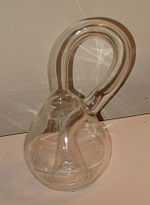Clifford Stoll
| Clifford Stoll | |
|---|---|
| Born |
June 4, 1950 Buffalo, New York |
| Alma mater |
SUNY Buffalo (BS) University of Arizona (PhD) |
Clifford Stoll (or Cliff Stoll) is an American astronomer and author. He is best known for his pursuit of hacker Markus Hess in 1986 and the subsequent 1989 book, The Cuckoo's Egg, which details his investigation. Stoll has written a total of three books as well as technology articles in the non-specialist press (e.g., in Scientific American on the Curta mechanical calculator and the slide rule).
Early life
Cliff Stoll received his PhD from University of Arizona in 1980. Cliff was married to Martha Stoll in the late 80's but they later divorced.
Career
During the 1960s and 1970s, Stoll was assistant chief engineer at WBFO, a public radio station in his hometown of Buffalo, New York.[1]
In 1986, while employed as a systems administrator at the Lawrence Berkeley National Laboratory, Stoll investigated hacker Markus Hess. After identifying the intrusion, he set up a honeypot for Hess, eventually tracking him down and passing details to the authorities. It is recognized as one of the first examples of digital forensics. At the time, gaining cooperation from law enforcement was a challenge due to the relatively new nature of the crime.[2] He described the events of his investigation in The Cuckoo's Egg: Tracking a Spy Through the Maze of Computer Espionage, and the paper "Stalking the Wily Hacker".[3] Stoll's book was later chronicled in an episode of WGBH's NOVA titled "The KGB, the Computer, and Me", which aired on PBS stations in 1990.[4]

In his 1995 book Silicon Snake Oil,[5] and an accompanying article in Newsweek[6] Stoll called the prospect of e-commerce "baloney". Stoll also raised questions about the influence of the Internet on future society, and whether it would be beneficial. He made various predictions in the article, e.g., about e-commerce (calling it nonviable due to a lack of personal contact and secure online funds transfers) and the future of printed news publications ("no online database will replace your daily newspaper"). When the article resurfaced on BoingBoing in 2010, Stoll left a self-deprecating comment: "Of my many mistakes, flubs, and howlers, few have been as public as my 1995 howler ... Now, whenever I think I know what's happening, I temper my thoughts: Might be wrong, Cliff ..."[7]
Additionally, Stoll sells blown glass Klein bottles through his company Acme Klein Bottles.[8] He was an eighth grade physics teacher at Tehiyah Day School, in El Cerrito, California,[9] and later taught physics to home-schooled teenagers.[10] Stoll was a regular contributor to MSNBC's The Site. Stoll is an FCC licensed amateur radio operator with the call sign K7TA.[11]
Bibliography
- Clifford Stoll (1989). The Cuckoo's Egg. New York: Doubleday. ISBN 0-370-31433-6.
- Clifford Stoll (1995). Silicon Snake Oil — Second thoughts on the information highway. ISBN 0-330-34442-0.
- Clifford Stoll (2000). High-Tech Heretic: Reflections of a Computer Contrarian.
Notes and references
- ↑ WBFO Alumni
- ↑ Simson L. Garfinkel (August 2010). "Digital forensics research: The next 10 years". Digital Investigation 7: S64-S73. doi:10.1016/j.diin.2010.05.009. ISSN 1742-2876.
- ↑ Clifford Stoll (May 1988). Stalking the wily Hacker 31 (5). Association for Computing Machinery.
- ↑ "The KGB, the Computer, and Me" Nova episode
- ↑ Clifford Stoll (1995). Silicon Snake Oil. McMillan. ISBN 0-330-34442-0.
- ↑ Clifford Stoll: The Internet? Bah! Newsweek, February 27, 1995
- ↑ Curmudgeonly essay on "Why the Internet Will Fail" from 1995 BoingBoing, February 26, 2010
- ↑ Peterson, Ivars (February 14, 2001). "Immersed in Klein Bottles". Science News. Retrieved December 1, 2013.
- ↑ Clifford Stoll: Clifford Stoll on Everything – 18 minutes with an Agile mind. TED conference February 2006
- ↑ Slashdot.org
- ↑ Stoll's callsign at QRZ.com
External links
- Stoll's page at Leigh Speakers Bureau
- Clifford Stoll at TED
- Appearances on C-SPAN
- Booknotes interview with Stoll on Cuckoo's Egg, December 3, 1989
- Clifford Stoll at the Internet Movie Database
- Works by or about Clifford Stoll in libraries (WorldCat catalog)
- Stalking the Wily Hacker copy at textfiles.com, May 1988
- Picture of Stoll from an interview with by Pro-Linux Magazine, February 9, 2005 (German)
- 2004 audio interview with Clifford Stoll by Karen Saupe (RealAudio)
- Cliff Stoll and Jonathan Zittrain on When Countries Collide Online: Internet Spies, Cyberwar, and Government Skullduggery, MediaBerkman, February 8, 2010 (1:21 h), Video (OGG video), Podcast (MP3, OGG audio)
- Talk by Cliff Stoll April 4, 1996
- "The KGB, the Computer, and Me" full Nova episode on YouTube